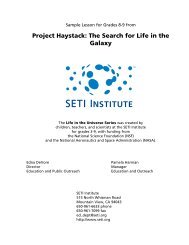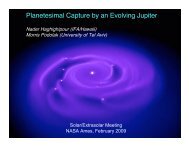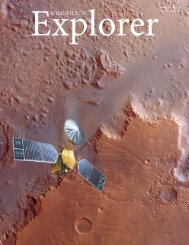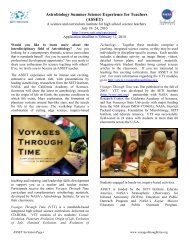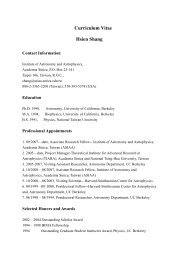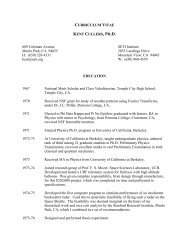Inside the Boardroom with Alan Bagley - SETI Institute
Inside the Boardroom with Alan Bagley - SETI Institute
Inside the Boardroom with Alan Bagley - SETI Institute
You also want an ePaper? Increase the reach of your titles
YUMPU automatically turns print PDFs into web optimized ePapers that Google loves.
Astrobiology<br />
Artist’s Concept of Deep Impact’s<br />
Encounter <strong>with</strong> Comet Tempel 1<br />
NASA/JPL/UMD<br />
Reacting to Disaster<br />
by Douglas Vakoch<br />
The scenario is familiar from Hollywood blockbusters<br />
like Armageddon and Deep Impact. A massive asteroid<br />
– perhaps ten miles in diameter – is headed straight<br />
for Earth. An all-out effort to deflect it is mounted. If<br />
<strong>the</strong> mission succeeds, civilization as we know it will<br />
continue.<br />
But if natural human reactions to threats interfere, <strong>the</strong> ending<br />
could be far from uplifting. If fear and denial postpone an adequate<br />
response, dust and debris could make <strong>the</strong> daytime sky look like<br />
night, <strong>the</strong> Earth’s surface could be razed by a global firestorm, and<br />
tsunamis could obliterate coastal cities.<br />
In <strong>the</strong>ory, threats from space may be detected far in advance<br />
of <strong>the</strong>ir arrival, giving plenty of time to deflect <strong>the</strong>m (see pages<br />
10 - 11) or at least prepare for <strong>the</strong> aftermath. But that’s in <strong>the</strong>ory.<br />
“What we may actually get,” says psychologist Albert Harrison, “is<br />
an obsessive focus on a very constricted range of options, a refusal<br />
to consider or integrate new data, defensiveness that prevents decision<br />
makers from appreciating threats and developing alternatives,<br />
and panicky, ineffective last-minute choices.”<br />
The result would be devastating. “In some respects,” Harrison<br />
suggests, “post-impact Earth may resemble an off-world destination:<br />
a dangerous place bombarded <strong>with</strong> harmful forms of radiation,<br />
a toxic atmosphere, and little or no useful vegetation.” If some<br />
part of humanity survives, its future may be bleak. In <strong>the</strong> case of<br />
extreme destruction,<br />
Harrison says, “hopes<br />
generated by looking<br />
forward to emerging<br />
from shelter will be overpowered<br />
by <strong>the</strong> realities<br />
of living on a dead and<br />
barren planet.”<br />
The Human<br />
Response<br />
As a social psychologist<br />
at <strong>the</strong> University of<br />
California at Davis,<br />
Harrison has long<br />
contemplated <strong>the</strong> impact<br />
of space, ranging from longduration<br />
spaceflights to<br />
<strong>the</strong> societal implications of<br />
12<br />
<strong>SETI</strong> <strong>Institute</strong> Explorer




